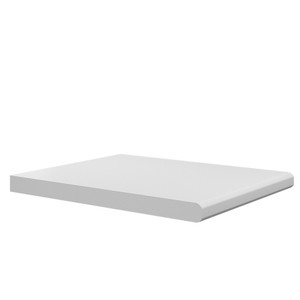MDF Shelves
Our MDF shelves work perfectly alongside wall panelling kits or as standalone shelving for any room. Each shelf is cut to your exact specifications, with custom sizing available if our standard options don't quite fit your project. All wall panels and shelving components are manufactured from the same high-grade MDF for consistent quality throughout your interior.
What Are MDF Shelves?
MDF shelves are cut from high-density fibreboard, giving you a smooth, consistent surface that's perfect for painted finishes. Unlike solid wood, there are no knots or grain variations to work around, making them ideal for built-in storage where you want clean lines.
Our shelves use moisture-resistant MDF, so they handle normal household humidity better than standard grades. Each shelf is manufactured to order, meaning we cut to your exact measurements rather than offering fixed sizes you have to work around.
The smooth surface takes paint exceptionally well. You get crisp edges and even coverage that's difficult to achieve with natural wood grain. This makes MDF shelves particularly good for bedroom storage and alcove shelving where the finish needs to match surrounding paintwork.
Size Options and Specifications
We can cut shelves from 50mm wide up to 400mm, in three thickness options:
15mm thickness - Suitable for light loads like books and decorative items. Keep spans under 600mm to prevent sagging.
18mm thickness - The most popular choice. Handles medium loads including kitchenware and heavier books up to 700mm spans.
25mm thickness - For heavier items or longer spans. The extra thickness provides better structural integrity for demanding applications.
Maximum length is 4200mm, though longer shelves benefit from additional support brackets. We cut to tolerances of +/-1mm, so measurements need to be accurate for proper fitting.
Edge Profile Options
Square Edge - Clean, sharp edges that work well for modern interiors and built-in applications. This is our most popular option as it suits most projects.
Bullnose Edge - Rounded front edge that feels softer to touch and looks less harsh than square profiles. Good for shelves at head height or in children's rooms.
Double Bullnose - Two rounded edges with a flat section between them. Creates visual interest while maintaining practical advantages of curved edges.
Double Chamfered - Two bevelled edges that catch light differently, adding subtle detailing. Works well in traditional interiors where simple curves might look too modern.
Finish Options
Unprimed - Raw MDF with no finish applied. Choose this if you're using specialist primers or want complete control over the preparation process.
Primed - Single coat of primer applied and sanded smooth. Ready for undercoat and final paint. Good for most standard paint systems.
Undercoated - Primer plus undercoat applied, ready for your final colour. This popular option saves preparation time and gives excellent coverage for lighter paint shades.
Matt Grey - Complete finish ready to install. No painting required if you're happy with the neutral grey colour. Includes touch-up paint for any installation marks.
Most customers choose undercoated shelves as they're ready for painting but still allow colour flexibility. The white undercoat provides good opacity and creates a professional base for most paint types.
Applications and Load Considerations
MDF shelves work well for floating shelves, alcove storage, and built-in units. They're particularly suited to painted built-ins where you want seamless integration with surrounding walls.
For floating shelves, use appropriate wall fixings rated for the combined weight of shelf and contents. The shelf thickness affects span capability, but wall support is usually the limiting factor.
In alcoves and built-in units, the side supports allow longer spans than floating installations. MDF's stability means shelves stay straight without the warping issues sometimes seen with solid wood.
Remember that MDF is moisture-sensitive, so avoid areas with direct water contact. Normal household humidity is fine, but bathroom installations need proper sealing and ventilation.




